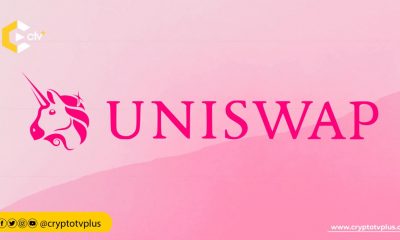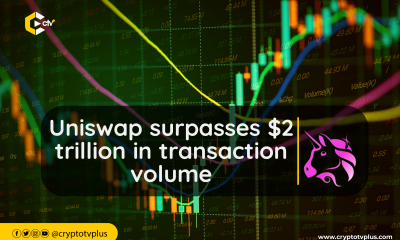DeFi
What Uniswap V4 might look like and why?

Uniswap, the popular decentralized exchange platform, is preparing to release its next version, Uniswap V4, amid a pressing need to maintain its dominance in the market.
The release of Uniswap V4 comes as the “business source license” for Uniswap V3 is set to expire in April, two years after its initial release. The license was put in place to prevent a repeat of the “vampire attack” seen with the Sushiswap fork, by forbidding forks of the V3 code for two years. With the expiration of the license approaching, a number of low-effort forks of Uniswap V3 will likely appear, potentially eroding Uniswap’s market dominance and revenue.
However, the main motivation for the release of Uniswap V4 is not simply the expiration of the license. Despite its dominance, Uniswap V3 still has a number of shortcomings and holes that need to be addressed. One key area of focus is the profitability of liquidity providers (LPs) on the platform, with many questioning whether it is still a viable option. Uniswap V4 aims to address these issues and improve the overall user experience.
Improved LP conditions
Initially, liquidity providers were able to achieve high annual percentage yields (APYs) on concentrated liquidity positions, however, many disregarded the risk of impermanent loss. Some large liquidity providers, like xtokenterminal, managed to reach $25 million in assets under management (AUM) on Uniswap V3 but decided to renounce the active management space altogether, due to the fact that providing unincentivized ambient liquidity on volatile Uniswap V3 pairs without a larger strategy is not a sustainable business model. The expected return is not worth the risk or opportunity cost.
Given these challenges, there are two potential paths for Uniswap V4 to consider. The first option is to abandon the liquidity provision model based on the constant product (XYK) model altogether. This model has been successful so far but it may have reached its limit of usefulness. Instead, Uniswap V4 could adopt a model where liquidity providers are paid, even in perpetuity, for the service of making a market that is normal and makes obvious sense.
The second potential path for Uniswap V4 is to compensate liquidity providers for the additional market-making risk they are exposed to during times of volatility utilizing dynamic trading fees. This way, during times of high volatility, trading fees would be higher, which would level the playing field for liquidity providers and make it more sustainable for them to provide liquidity on the platform.
Improved UX
Uniswap V4 might also aim to improve the user experience (UX), as the most widely used decentralized exchange on the platform.
The company’s acquisition of NFT aggregator @geniexyz suggests that Uniswap is looking to expand its role in the ecosystem beyond just being a decentralized exchange and to own the aggregation layer that will soon tap into mobile apps, catering to a broader audience.
With Uniswap V4, the company might be looking to shift its model from being just a decentralized exchange to more of a decentralized execution engine. This would involve a more intricate and complex stack, with the primary user interaction being a signature instead of a direct transaction.
This would open up a lot more design space and allow for more complex transaction types, such as limit orders of any duration, to be built natively into the protocol. This could make Uniswap more accessible and user-friendly, making it more attractive to a wider audience.
Increased scalability
The current version of the protocol, Uniswap V3, is limited by the Ethereum network’s capacity, leading to high gas fees and slow transaction times. With the adoption of Ethereum 2.0 and the roll-out of layer 2 solutions, Uniswap V4 may be able to handle a much larger volume of transactions without experiencing these issues.
Ethereum 2.0 is a major upgrade to the Ethereum network that aims to improve its scalability, security, and decentralization. One of the key components of Ethereum 2.0 is the use of sharding, which allows the network to process transactions in parallel rather than sequentially. This can greatly increase the capacity of the network, enabling it to handle more transactions without becoming congested.
Layer 2 solutions, on the other hand, are protocols that operate on top of the Ethereum network, allowing transactions to be processed off-chain. This can also help to increase the scalability of the network, as it reduces the load on the main chain. Some examples of layer 2 solutions include Optimistic Rollup, ZK-Rollup, and Validium. By adopting these technologies, Uniswap V4 may be able to significantly improve its scalability and provide a better user experience for traders.
Improved liquidity
Uniswap V3 will probably be an off-chain orderbook built on top of Uniswap v3 to target a more mainstream trading audience.
Uniswap has always been known for its liquidity, with users able to easily buy and sell a wide range of assets. However, with the growing competition from other decentralized exchanges and the increasing number of assets being traded on the platform, Uniswap may look to further enhance its liquidity in order to remain competitive.
Enhanced security
While decentralized exchanges have generally been considered more secure than centralized ones, there have been instances of hacks and other security breaches on Uniswap. The development team behind Uniswap may look to implement additional security measures to protect user assets and maintain the platform’s reputation.
So why might Uniswap V4 be significant?
The decentralized exchange space is highly competitive, and Uniswap has established itself as a leader in the field. However, with the increasing adoption of decentralized finance and the emergence of new players in the market, Uniswap will need to continue to innovate to stay ahead.
By introducing new features such as increased scalability, improved liquidity, and enhanced security, Uniswap V4 may be able to further cement its position as the go-to platform for decentralized trading. Additionally, the potential introduction of new governance mechanisms could give users a greater say in the direction of the platform, making it even more attractive to the community.
What do you think of this article? Share your comments below.

























1 Comment